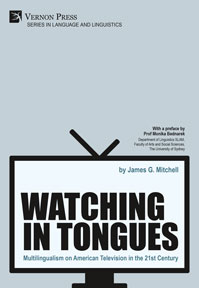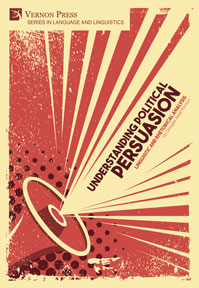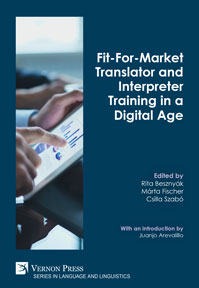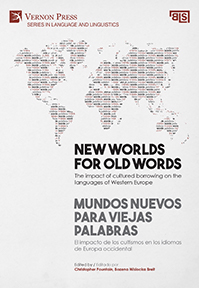Analyzing Multimodality in Specialized Discourse Settings
Innovative Research Methods and Applications
Veronica Bonsignori, Belinda Crawford Camiciottoli, Denise Filmer (Eds.)
by Anthony Baldry (University of Messina, Italy), Deirdre Kantz (University of Pavia, Italy), Francesca Coccetta (Ca’ Foscari University of Venice, Italy), Elisa Mattiello (University of Pisa), Costanza Cucchi (Università Cattolica del Sacro Cuore of Milan, Italy), Francesca Seracini (Università Cattolica del Sacro Cuore of Milan, Italy), Gianmarco Vignozzi (University of Pisa, Italy), Veronica Bonsignori (University of Rome “Foro Italico”, Rome, Italy), Denise Filmer (University of Pisa, Pisa, Italy), Belinda Crawford Camiciottoli (University of Pisa, Pisa, Italy)
Purchase this book
(click here to change currency)
This volume collects a series of cutting-edge contributions devoted to different research strands whose unifying theoretical framework is represented by multimodality. This background has been adopted to explore different examples of specialized discourse and genres not all of which have yet been deeply analyzed.
As the editors themselves claim in their preface, “the contribution of non-verbal forms to meanings in specialized discourse is likely to assume an increasingly prominent role thanks to ongoing technological advances that facilitate the creation and reproduction of multimodal texts across domains of usage” (page 2). This is also confirmed by a marked preference of contemporary society for communicating through the visual medium, which has become a privileged instrument in our age, the era of the image.
This volume intentionally assembles essays that analyze different genres and discourse types, with the common purpose of showing how communication fully exploits all semiotic channels in the process of meaning-making. As the chapters show, multimodal affordances can be exploited to communicate information, disseminate research results, and attract potential customers in a vast array of genres. At the same time, another merit of this volume is that it features practically-oriented investigations with flexible and engaging tools to be employed in learning environments. These examples could be used to make students fully aware of the instruments, resources and strategies to communicate effectively in specialized settings.
The wide coverage and the currently relevant topics make this volume a precious instrument for academics and students alike.
Dr. Silvia Bruti
Director of the University language Centre (Cli)
Full Professor of English Language and Translation
Dept. of Philology, Literature, Linguistics
University of Pisa, Italy
This is a very interested and highly relevant volume. It is based on two premises: multimodality and specialized discourse analysis. Starting from the works by Swales (1990) on how to analyse texts according to the recurring linguistic and rhetorical features, this field of research has incorporated the ideas by Gotti (2003) on the application of specialized discourse in two spheres: communication between experts and communication from the expert to the non-expert. Moreover, Kress’s (2010) studies revolutionized the study of discourse by opening the researchers’ eyes to the multimodal dimension, and studies such as those by Prior (2013) and Plastina (2013) have developed this idea and have advanced towards the multimodal analysis of specialized texts.
The topics and approaches are varied, including academic, economic, legal, medical and political domains. Moreover, the several chapters focus on different perspectives, some focus on the research method (chapter 1), other on the application of freely available materials to ESP teaching (chapter 4), on the features of certain website sections in corporate and law firms (chapters 5 and 6), on genres teaching (lecture in chapter 3) and research genres (video abstracts in chapter 2), or on the political discourse of British female Prime Ministers (chapter 7).
Multimodality and multimodal discourse analysis are becoming more and more relevant these days. This book is relevant and updated; it consists of interesting and varied chapters in terms of topics and approaches, which, even so, form a cohesive volume. The research is well-founded, and the results in each of the chapters are robust and conclusive. For all these reasons, I recommend the publication of this book.
Dr. Inmaculada Fortaneti
Professor and researcher
Universitat Jaume I, Spain
“Analyzing Multimodality in Specialized Discourse Settings: Innovative Research Methods and Applications” collects some original articles and includes a rich preface by the editors. The focus of all contributions is on the use of English for Specific Purposes in higher education and on specialized discourse at large. Although the topic is not new in its own right, the approach adopted by the authors and the editors is quite innovative. The underlying idea is that meaning-making in specialized discourse relies as much on the verbal component of language as on non-verbal communicative resources. For this reason, instances of specialized discourse in educational settings are investigated from a multisemiotic perspective through different methodological approaches, ranging from corpus linguistics to critical discourse analysis, both synchronically and diachronically. The discourse domains tackled are also varied and include tourism, economics, medicine, and the academia. Given the growing role played nowadays by non-verbal communicative strategies in meaning-making in specialized communication, including in educational settings, the studies collected in the volume offer a pioneering way to tackle the many questions raised by the evolution of discursive practices in different sectors. They propose methodological suggestions for the investigation of such practices and the exploitation of this knowledge in ESP teaching. Consequently, the volume has the merit of being a useful resource for both linguists and ESP teachers alike, especially for those interested in understanding the mechanisms behind effective and appropriate professional communication and wishing to bring action research to the language classroom.
Dr. Gloria Cappelli
Professor, Dipartimento di Filologia, Letteratura e Linguistica
Università di Pisa, Italy
Contemporary society has witnessed radical changes in the field of communications in terms of how messages and meanings are disseminated. Digitalization and the Internet have signalled an exponential rise in the circulation of multimodal texts in which different semiotic resources are orchestrated together to construct meaning in all areas of social life, across languages and cultures, and in diverse specialized discourse domains. This has foregrounded the need to examine the semiotic functions, affordances, and issues at stake in a range of multimodal discourse forms, while simultaneously highlighting the importance of critical multimodal literacy in audiences and learners.
This volume develops and extends pioneering research on the intersection between multimodality and specialized discourse. Seven newly commissioned studies offer innovative perspectives on multimodal research methodologies and applications in a variety of ESP (English for Specific Purposes) contexts for practitioners and scholars alike. The volume offers a glimpse at future directions in this dynamic and ever-evolving area of investigation focusing on the synergy between verbal and non-verbal modes of communication in the digital age. Each chapter explores an original area of application: academic, economic, scientific, marketing, legal, medical, and political. The contributors approach multimodality from a range of theoretical and methodological viewpoints including synchronic and diachronic corpus-based and corpus-aided studies, critical discourse analysis, and systemic functional linguistics. Analytical tools such as multimodal (critical) discourse analysis, multimodal transcription, and multimodal annotation software capable of representing the interplay of different semiotic modes - speech, intonation, direction of gaze, facial expressions, gesturing, and spatial positioning of interlocutors - are employed. The diversity of research strands contained in the volume illustrates just some of the vast areas of multimodal knowledge dissemination that are still unmapped. As a cornerstone of communication, multimodality needs exploring in all its facets. These contributions aim to further that cause.
List of figures
List of tables
Foreword
Marina Bondi
University of Modena and Reggio Emilia, Italy
Preface
Belinda Crawford Camiciottoli
University of Pisa, Italy
Veronica Bonsignori
University of Rome “Foro Italico”, Italy
Denise Filmer
University of Pisa, Italy
Chapter 1
Corpus-assisted Approaches to Online Multimodal Discourse Analysis of Videos
Anthony Baldry
University of Messina, Italy
Deirdre Kantz
University of Pavia, Italy
Chapter 2
Video Abstracts in EMP: A Corpus-Based Approach to the Analysis of Rhetorical Structure in Multimodal Medical Genres
Francesca Coccetta
Ca’ Foscari University of Venice, Italy
Chapter 3
The I-you Connection in Humanities and Social Sciences Lectures: Multimodal Insights
Belinda Crawford Camiciottoli
University of Pisa, Italy
Chapter 4
Using Google Talks in ESP Educational Settings: A Multimodal Approach
Elisa Mattiello
University of Pisa, Italy
Chapter 5
Representations of the Ideal Workplace in Multimodal Texts: Employer Branding on the Career Pages of Corporate Websites
Costanza Cucchi and Francesca Seracini
Università Cattolica del Sacro Cuore of Milan, Italy
Chapter 6
“What are Miranda Rights?”: The Case of Video FAQs on a Criminal Law Firm Website
Gianmarco Vignozzi
University of Pisa, Italy
Chapter 7
“As my Right Honourable Lady knows…”: A Multimodal Critical Discourse Analysis of Prime Minister’s Question Time Comparing Margaret Thatcher and Theresa May
Veronica Bonsignori
University of Rome “Foro Italico”, Italy
Denise Filmer
University of Pisa, Italy
Contributors
Index
Veronica Bonsignori (PhD, English Linguistics) is a research fellow in English Language and Linguistics at the University of Rome “Foro Italico”. Her interests are in the fields of pragmatics, audiovisual translation, multimodality, and ESP. She has published several articles in national and international journals and collections. She has also authored the monograph 'English Tags: A Close-up on Film Language, Dubbing and Conversation' (2013) and co-edited with Belinda Crawford Camiciottoli the volume 'Multimodality Across Communicative Settings, Discourse Domains and Genres' (2016). Her most recent publications include the paper 'Using films and TV series for ESP teaching: A multimodal perspective' (System, 2018) and 'A multimodal analysis of spoken medical English in expert-to-expert interaction in TV programmes' (Ibérica, 2019).
Belinda Crawford Camiciottoli (PhD, Applied Linguistics) is Associate Professor of English Language and Linguistics at the University of Pisa. Her research focuses primarily on corpus-assisted discourse analysis to investigate the lexico-grammatical, discursive, pragmatic, rhetorical, multimodal, and intercultural features of discourse in academic, professional, and digital settings. She has published extensively in leading international journals including 'Journal of Pragmatics, English for Specific Purposes', and 'Text & Talk'. She co-edited the volume 'Multimodal analysis in academic settings. From research to teaching' in the Routledge Studies in Multimodality Series (2015), as a well as a Special Issue of System entitled 'Multimodal perspectives on English language teaching in higher education' (2018).
Denise Filmer (PhD, Translation Studies) is a research fellow in English language and translation at the University of Pisa, Italy. Adopting multimodal critical discourse analysis approaches, her research investigates the role of translation in media representations of political discourse, gender and sexuality, and the current migrant crisis. She has authored a monograph entitled 'Racial Slurs: Last Linguistic Taboo and Translational dilemma' (Lambert Academic Publishing 2012), contributed to volumes published by John Benjamins and Routledge and published widely in international journals, including 'Perspectives: Studies in translatology, Cultus: International journal of intercultural mediation and communication', and the 'European Journal for Language Policy'.
Multimodality, multimodal discourse analysis, multimodal critical discourse analysis, multimodal corpora, corpus-assisted analysis
See also
Bibliographic Information
Book Title
Analyzing Multimodality in Specialized Discourse Settings
Book Subtitle
Innovative Research Methods and Applications
ISBN
978-1-64889-103-8
Edition
1st
Number of pages
200
Physical size
236mm x 160mm

![Analyzing Multimodality in Specialized Discourse Settings [Hardback]](/file/15959/78ffd0c1a43c9757e01e06048304e26a/1638265706.jpg)






